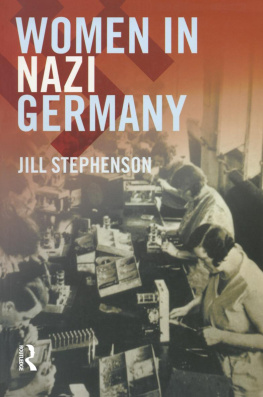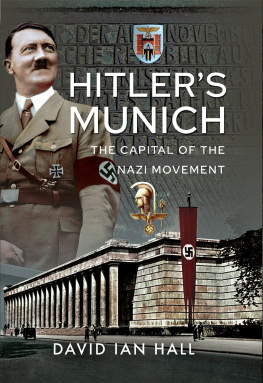Social Life, Local Politics, and Nazism
1986 The University of North Carolina Press
All rights reserved
Manufactured in the United States of America
94 93 92 91 90 6 5 4 3 2
Library of Congress Cataloging-in-Publication Data
Koshar, Rudy.
Social life, local politics, and Nazism.
Bibliography: p.
Includes index.
1. Marburg (Germany)Politics and government. 2. Marburg (Germany)Social life and customs. 3. National socialism. 4. Middle classesGermany (West)MarburgPolitical activity. I. Title.
DD901.M283K67 1986 943.41 85-28958
ISBN 0-8078-1694-9
ISBN 0-8078-4287-7 (pbk.)
Publication of this book has been aided by a subvention
from the University of Southern California.
Designed by Ron Maner
THIS BOOK WAS DIGITALLY MANUFACTURED.
For Judy, Drew, and Annelise
Contents
Tables
1-1 Population in Marburg, by Major Economic Categories, 1925 and 1933
1-2 Major Groups in Marburg Work Force, 1925 and 1933
2-1 Reichstag Voting in City of Marburg, 18711912
2-2 Occupations of Members of Five Political Parties in Marburg, 1906, 1908, and 1913
2-3 Reichstag Voting for Major Parties in Marburg, 19191933
2-4 City Parliament Elections in Marburg, 19191933
2-5 Percentage Distribution of Occupations of Nonstudent Members for Selected Party Categories in Marburg, 19191933
4-1 Percentage Distribution of Occupations of Social Organization Officials in Marburg, 18801936
4-2 Membership Changes in Fourteen Marburg Voluntary Organizations, 19141933
4-3 Membership in Marburg Student Organizations, Summer Semesters, 19141933
6-1 Marburg NSDAP Members Cross-Affiliations, Compared to Sample Joiners
6-2 Timing of Nazi Students Affiliations with Non-Nazi Voluntary Organizations, 19261934
6-3 Percentage Distribution of NSDAP Nonstudents Cross-Affiliations, by Type of Affiliation, Compared to Sample Joiners, 19231935
6-4 Percentage Distribution of Nazi Students Affiliations, by Type of Student Organization, 19261935
6-5 Percentage Distribution of Nonstudent NSDAP Joiners, by Social Strata and Occupational Subgroups, Compared to Sample Joiners, 19231935
6-6 NSDAP and Sample Householders per Thousand Householders, by Strata and Occupational Subgroups, in Precincts with Highest and Lowest Nazi Recruitment, 19231933
6-7 Percentage Distribution of Occupations of Nonstudent NSDAP and Other Political Party Members in Marburg, 19191935
A-1 Marburg NSDAP Members Cross-Affiliations, 19231935
A-2 An Estimate of the Percentage Distribution of Voluntary Organizations in Marburg, 19141934
A-3 Organization Density in Six Cities
Illustrations
Two contrasting views of Marburg
Map of Marburg in 1927
The Ketzerbach Neighborhood Association, 1912
The Song Club Liederkranz, 1920
The Marburg Volunteer Fire Department, 1934
Marburgs oldest student dueling fraternity, the Corps Teutonia, 1925
Fraternity ritual
Fraternity sociability
Town and gown
A Marburg dueling fraternity, Burschenschaft Arminia, 1935
Marburg anti-Semitism
Nazi ritual
The swastika appears
Goering in Marburg
Preface
This book discusses the organizational fabric of politics and the rise of the National Socialist party in a single German city. Its goal is to embed a discussion of the Nazi movement in a broad social and chronological framework while avoiding a teleological interpretation that makes of this framework a simple prehistory of German fascism. The setting is Marburg an der Lahn, a Hessian university town where the Nazi party received early and above-average electoral support. I became interested in the topic partly because I thought that most case studies of the 1930s suggested the importance of a longer time frame in understanding the genesis and evolution of the NSDAP (Nationalsozialistische Deutsche Arbeiterpartei) but treated developments prior to 1918 and large parts of Weimar history superficiallyas general background rather than as integral chapters in the rise of Hitlers violent politics. Moreover, I thought that studies of the organizational genealogy of the Nazi movement captured only a narrow range of social ties based on national political parties, economic pressure groups, and protofascist associations. Although I recognized the importance of these groups, I thought that the majority of Nazi party members also received a political education from mundane social organizations of ordinary joiners. I became convinced that the everyday substructures of local politics were also the substructures of German fascism and that informal diffusion of Nazi ideology through quotidian organizational networks was as important to the NSDAP as were propaganda, the personality cult of Hitler, and conspiratorial infiltration of voluntary groups by activists.
I wanted to reconstruct that part of a towns organizational ecology in which the Nazi party gained success. I aimed to study apparently unpolitical social clubs as well as pressure groups and local parties. Although many groups in which the NSDAP gained support claimed that they shut out contentious party politics, they also gave Germans a chance to talk about political events, form contacts, and gain parliamentary skills. In my view, the apoliticism of many voluntary associationsa much discussed though insufficiently analyzed aversion to mass parties and the political marketplace that produced themwas not based on a misunderstanding of power relations but rather contained the raw materials of an ideology of a particular mode of political practice, and of a common sense with diverse origins and textures. Rejecting mass parties as the sole or dominant instruments of national political representation, many voluntary organizations used apoliticism after the late nineteenth century to build an antisocialist movement, an effort which Nazi agitators eventually exploited by mobilizing diverse social networks. The small-town bourgeoisiea community of sentiment including the Protestant, nonsocialist upper middle, lower middle, and working classeswas a leading force in such processes. Yet scholars of modern Germany have devoted more attention to working-class milieus than to local bourgeois groups. My study will, I hope, fill part of this gap.
I am interested in the nexus formed by bourgeois voluntary associations, party politics, and the National Socialist movement between the late nineteenth century, when a surge of organization building occurred throughout Germany, and late 1935, when the first stage of Nazi coordination of voluntary group life was completed. Readers who are looking for a blow-by-blow history of local associations or political events will be disappointed. Similarly dissatisfied will be those who want a full discussion of the diverse motivations and interests nested in one citys voluntary groups. These are important issues, but tackling them would have made this an unmanageable and overly long project. My study assumes that at particular historical junctures dissimilar groups experience similar stresses and confront similar issues. The goal is therefore to discuss a greater range of voluntary associations than most previous studies of German political history have, to watch different organizations interact in the dance of local power relationships, and to trace those groups in the evolution of the Nazi party. In the latter task I place particular emphasis on the organizational roots of Nazi mobilization and the cross-affiliations of Nazi party members. I think the advantages of this approach outweigh the disadvantages, and it is hoped that this book will encourage further discussion of how to study Germanys fascinating maze of local clubs and associations.





